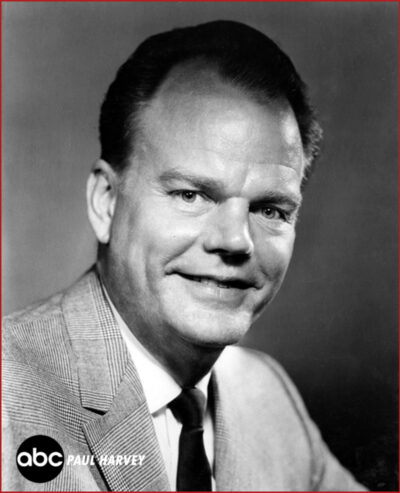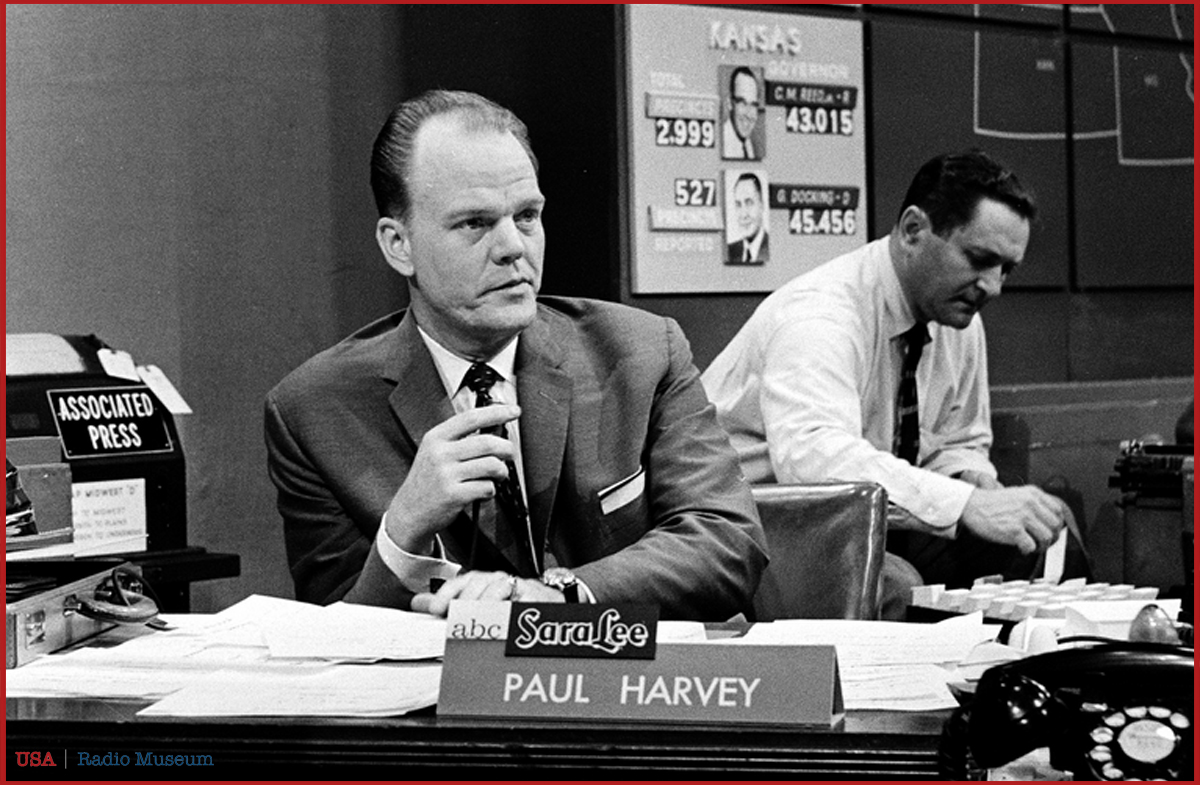Paul Harvey: The Voice That Defined American Radio Introduction: The Power of a Voice Some voices are unforgettable. They carry the weight o
Paul Harvey: The Voice That Defined American Radio
Introduction: The Power of a Voice
Some voices are unforgettable. They carry the weight of history, the warmth of familiarity, and the clarity of truth. Paul Harvey’s voice was one of them. For more than six decades, his crisp delivery, dramatic pauses, and signature phrases—“Stand by… for news!” and “Paul Harvey… Good Day!”—became part of the fabric of American life.
Harvey was not just a radio broadcaster; he was a storyteller, a journalist, and a historian, weaving news with commentary and wisdom in a way that captivated millions. His influence extended beyond radio, shaping the way stories were told, news was delivered, and voices resonated in the hearts and minds of his audience.
A Humble Beginning in Tulsa
Paul Harvey Aurandt was born on September 4, 1918, in Tulsa, Oklahoma. His father, a police officer, was tragically killed in the line of duty when Harvey was just three years old. Despite this hardship, young Paul developed a keen interest in storytelling and radio, often tinkering with electronics and listening to broadcasts.
By age 14, Harvey secured a job at KVOO in Tulsa, initially cleaning up the studio before earning a chance to read commercials and news bulletins. His talent quickly emerged, and his voice became a familiar presence in the Oklahoma airwaves.
 From Local Radio to National Fame
From Local Radio to National Fame
Harvey’s career took him through stations in Kansas, Missouri, and Illinois, where he refined his craft. In 1944, he moved to Chicago, broadcasting on ABC affiliate WENR. It was here that Paul Harvey News and Comment was born, a program that blended news, editorial perspectives, and human-interest stories with his signature delivery.
His ability to infuse emotion and storytelling into news reporting set him apart. By 1951, his program was broadcast nationally, and Harvey became a household name. Listeners tuned in daily to hear not just headlines but stories that mattered, told in a way only he could.
The Rest of the Story
One of Harvey’s most famous segments, The Rest of the Story, premiered in 1976. Originally a feature within his newscasts, it grew into a daily syndicated program, uncovering unexpected twists behind historical events and figures. Written and produced by his son, Paul Harvey Jr., the program’s famous closing line—“And now you know… the rest of the story.”—became legendary.
Through these broadcasts, Harvey transformed storytelling into an art form, making listeners think, reflect, and appreciate history in a new light.
Paul Harvey | Cigarette Ads | The Rest of The Story
Audio Digitally Remastered by USA Radio Museum
Broadcasting Style: A Voice Like No Other
Harvey’s voice was clear, authoritative, and unmistakable. He mastered the use of dramatic pauses, giving weight to every word. His ability to infuse warmth, humor, and wisdom into his commentaries created an unparalleled bond with his audience.
Beyond his style, Harvey’s integrity in journalism set him apart. He expressed conservative yet independent views, ensuring his commentary was thoughtful rather than polarizing. His editorial choices reflected his belief in individual responsibility, traditional values, and unwavering optimism.
Paul Harvey’s commentaries had a profound impact on listeners, shaping public discourse and leaving a lasting impression on American culture. His distinctive storytelling style, combined with his ability to blend news with personal reflection, made his broadcasts deeply influential.
Impact on Listeners
- Emotional Connection: Harvey’s commentaries resonated with audiences because of his warm, authoritative voice and dramatic pauses, which made his stories feel personal and engaging.
- Moral & Social Reflection: His famous monologue, If I Were the Devil (1965), warned of societal decline and moral decay, and it continues to spark discussion today.
- Historical Perspective: His The Rest of the Story series provided fascinating insights into historical events and figures, often revealing unexpected twists that changed how people viewed history.
- Reassurance in Difficult Times: During moments of national crisis, such as the assassination of President Kennedy (1963) and September 11, 2001, Harvey’s commentaries provided comfort and perspective, helping listeners process grief and uncertainty.
- Influence on Journalism & Broadcasting: His ability to seamlessly integrate news, commentary, and storytelling set a standard for radio journalism, inspiring generations of broadcasters.
Paul Harvey’s legacy as a master communicator remains strong. His words had a way of sticking with people, making them think, reflect, and sometimes even change their perspectives.
Paul Harvey | Mick Jagger | The Rest of The Story
Audio Digitally Remastered by USA Radio Museum
Iconic Commentaries
Paul Harvey had countless memorable broadcasts, but a few stand out as truly iconic:
- “If I Were the Devil” (1965) – One of his most famous monologues, Harvey imagined how the devil would corrupt society, warning of moral decay and societal decline. His words remain eerily relevant today. You can listen to it here.
- “The Rest of the Story” Series – This daily segment featured fascinating untold stories about historical figures, events, and inventions, always ending with his signature phrase: “And now you know… the rest of the story.” You can find a collection of these broadcasts here.
- Al Capone’s Musical Side – A surprising tale about how the infamous gangster formed a band while in prison, showing a different side of his personality. Listen to it here.
- Julie Andrews’ Early Singing Talent – A heartwarming story about how the legendary actress discovered her voice in air raid shelters during World War II. Check it out here.
- Harry Truman’s Atomic Bomb Decision – A deep dive into the difficult choice Truman faced regarding the use of nuclear weapons. Hear the full story here.
Paul Harvey’s storytelling was unmatched, blending history, mystery, and wisdom in a way that captivated millions. Harvey’s words carried profound impact, and certain broadcasts remain etched in history:
- November 22, 1963 – His somber yet insightful reflection on President John F. Kennedy’s assassination was one of his most poignant broadcasts.
- September 11, 2001 – Harvey’s post-9/11 commentary captured the raw emotions of a grieving nation, offering comfort and perspective during uncertain times.
Each of these moments showcased his ability to take national tragedy, moral dilemmas, and historical turning points, and turn them into something thought-provoking and deeply personal for his listeners.
Paul Harvey | November 22, 1963 | Commentary
Audio Digitally Remastered by USA Radio Museum
Honorable Mention: The Woman Behind the Legend
Behind every great broadcaster is a visionary, and for Paul Harvey, that person was his wife, Lynne “Angel” Cooper Harvey. More than just his life partner, she was his producer, manager, and creative force, shaping his career in ways that made him a household name.
Lynne was born on October 4, 1916, in St. Louis, Missouri, and was a Phi Beta Kappa graduate of Washington University in St. Louis. She met Paul Harvey in 1939, and after a whirlwind romance, they married in 1940. She was instrumental in developing The Rest of the Story, pioneering radio news formats, and even becoming the first producer inducted into the Radio Hall of Fame.
In 2007, Harvey revealed that Lynne had been diagnosed with leukemia. She passed away on May 3, 2008, at the age of 91. Her death deeply affected Paul, and he continued broadcasting for only a short time before his own passing in 2009.
Together, they had one son, Paul Harvey Jr., who followed in his father’s footsteps, writing and producing The Rest of the Story. Their partnership—both personal and professional—was one of the most enduring and influential in radio history.
Paul and Lynne now rest together at Forest Home Cemetery in Illinois, in an unmarked mausoleum, side by side—just as they were in life.
Recognition and Influence
Paul Harvey’s contributions to journalism and broadcasting did not go unnoticed. In 2005, he received the Presidential Medal of Freedom, the highest civilian honor in the United States, recognizing his impact on media and public discourse.
Many broadcasters, including Rush Limbaugh, Mike Rowe, and Garrison Keillor, credited Harvey as an inspiration. His storytelling influenced radio journalism, podcasts, and even televised news formats.
Paul Harvey was inducted into the Radio Hall of Fame in 1990, cementing his legacy as one of the most influential voices in American broadcasting. His contributions to journalism and storytelling earned him numerous accolades throughout his career.
Paul Harvey | Cassius Clay | The Rest of The Story
Audio Digitally Remastered by USA Radio Museum
Other Notable Honors & Awards
- Presidential Medal of Freedom (2005) – The highest civilian honor in the U.S., awarded by President George W. Bush for his contributions to media.
- National Association of Broadcasters Hall of Fame (1979).
- Five NAB Marconi Awards for Network/Syndicated Personality of the Year (1989, 1991, 1996, 1998, and 2002).
- Oklahoma Hall of Fame (1955).
- 11 Freedom Foundation Awards.
- Radio’s Man of the Year.
- American of the Year.
- Father of the Year.
- Legion of Honor.
Paul Harvey’s impact on broadcasting was unparalleled, and these honors reflect his enduring influence on journalism and storytelling.
Paul Harvey’s commentaries had a profound impact on listeners, shaping public discourse and leaving a lasting impression on American culture. His distinctive storytelling style, combined with his ability to blend news with personal reflection, made his broadcasts deeply influential.
The Final Broadcast & Legacy
Despite health challenges, including vocal cord surgery in 2001, pneumonia in 2008, and declining health after his wife’s passing, Harvey continued broadcasting until February 16, 2009. He passed away just 12 days later, on February 28, 2009, at the age of 90, in Phoenix, Arizona.
His legacy remains one of the most enduring and influential in American broadcasting, proving that one voice can change the way a nation listens.
Why Paul Harvey Still Matters
Paul Harvey’s legacy is not just in his archived broadcasts but in the very way news and storytelling are approached today. He proved that journalism could be engaging, insightful, and deeply personal, elevating news beyond mere headlines to something meaningful and timeless.
He didn’t just report the news—he made people feel it. He didn’t just tell stories—he made them unforgettable. And even years after his final broadcast, his words still echo through the airwaves, reminding us that he wasn’t just a broadcaster, but a voice that shaped the way we listen to stories.
Paul Harvey. The name. The voice. Truly, a national treasure.
_____________________
A USARM Viewing Tip: On your mobile or tablet device? Finger-tap the above images inside the post and stretch image across your device’s screen for LARGEST digitized view.

